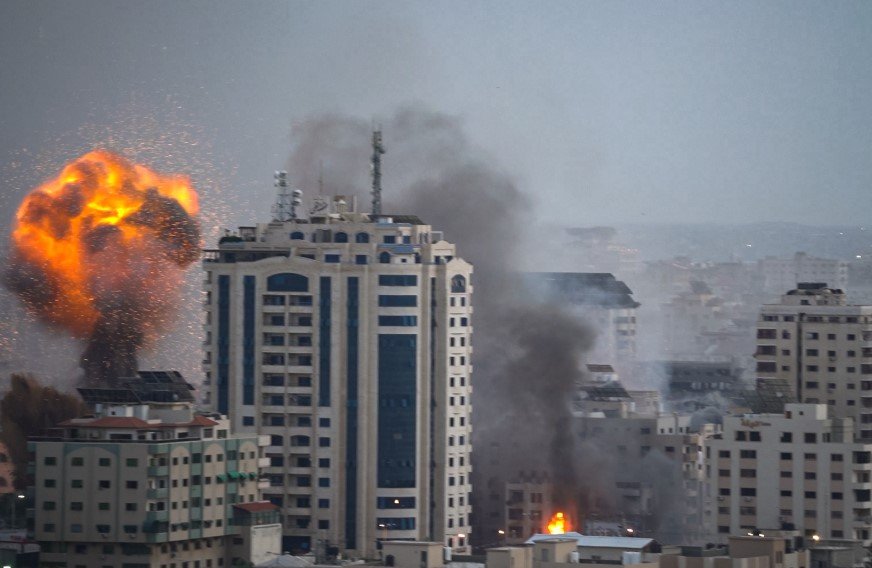Civilian toll climbs sharply while ceasefire remains elusive; Trump breaks silence, calling the conflict a “global wound”
Israeli forces have issued a fresh evacuation order to residents in northern Gaza, heightening fears of an expanded ground operation just days after some of the deadliest airstrikes in months. At the same time, U.S. President Donald Trump made his most direct call yet for an end to the Gaza war, describing the ongoing violence as “a stain on the conscience of the world.”
It’s the first time in weeks that Tel Aviv and Washington’s political timelines seem to brush against each other, though for Gazans on the ground, the consequences are immediate—and devastating.
Evacuation order triggers fresh waves of panic in Gaza City
Israeli military aircraft dropped leaflets across neighborhoods in northern Gaza early Sunday morning, warning civilians to flee south immediately. The areas targeted for clearance reportedly include Shujaiya, Beit Lahia, and parts of Gaza City.
Crowds surged toward already overcrowded southern shelters, some on foot, others in battered vehicles or donkey carts. Several witnesses told Reuters they had no idea where to go.
One man, Jamal Abu Rami, said simply, “There is no south left. Only death follows us now.”

At least 140 killed in latest strikes as humanitarian situation worsens
Gazan health officials say 140 Palestinians were killed over a 24-hour period ending Saturday night. That includes dozens of women and children, many of whom were hit while seeking aid or shelter. Strikes flattened tent camps and tore through a UN-run school compound.
One aid worker described the aftermath of a Friday night airstrike on a civilian food line as “a massacre in slow motion.”
And yet, the bombings show no sign of slowing.
In the midst of all this, Israel maintains its operations are surgically targeting Hamas holdouts. But even close allies are beginning to doubt that narrative.
Trump steps into spotlight with call to stop war “immediately”
For weeks, President Trump had stayed publicly silent on the Gaza situation—perhaps wary of injecting himself into yet another international crisis. That changed Sunday, when he addressed reporters from the White House.
“The war in Gaza must stop. Immediately. This is not just about the Middle East—it’s about all of us,” Trump said, adding that he had spoken to unnamed “key actors” over the weekend.
He didn’t elaborate. But insiders in the administration say backchannel talks with Israel and Egypt have resumed, with new pressure coming from a coalition of European leaders and Arab allies.
Trump also referred to the conflict as a “global wound,” language far stronger than the White House had used in months.
US influence still visible—but far less effective than before
Back in January, a U.S.-brokered ceasefire held for nearly six weeks. It was fragile, yes, but it allowed trucks full of aid and fuel to reach Gaza, and gave civilians a brief sense of stability. That calm shattered when Israeli troops stormed Deir al-Balah in mid-February.
Now, despite repeated calls from U.S. and European leaders, Israel appears to be going its own way.
-
Egypt and Qatar have warned that ongoing bombardments could derail ceasefire progress
-
EU foreign ministers are reportedly drafting new pressure tactics, including arms export restrictions
-
Meanwhile, domestic pressure on Netanyahu’s government is increasing from both left and right
“We want peace, but not at the cost of our safety,” Israeli Cabinet Minister Bezalel Smotrich told Army Radio, defending the new evacuation orders.
Aid groups sound alarm as shelters overflow
The United Nations Relief and Works Agency (UNRWA) said Sunday that more than 2 million Gazans—nearly the entire population—have now been displaced.
One UN field coordinator described the shelter conditions as “inhumane, untenable, and collapsing by the hour.” Makeshift bathrooms are overflowing. Water supplies are down to a trickle. Food aid has become erratic at best.
Here’s a breakdown of humanitarian impact, based on figures from OCHA:
| Category | Number Impacted | Notes |
|---|---|---|
| Displaced persons | 2.1 million | 91% of population |
| Food insecure | 1.8 million | Classified as severe |
| Hospitals functional | 7 out of 36 | Shortages of fuel and supplies |
| Civilian casualties | 38,400+ | UN estimate since October |
An UNRWA spokesperson told local radio, “We are watching a civilian collapse in slow motion. And the world is watching it with us.”
Political pressure mounts inside Israel and abroad
Back in Jerusalem, not everyone agrees with the military’s latest moves. Lawmakers from the center and left have warned Prime Minister Netanyahu that his hardline stance could isolate Israel even further. Protesters again gathered in Tel Aviv this weekend calling for early elections.
Some protest signs read: Enough is enough. Ceasefire now.
Others took a more biting tone: You can’t bomb your way to peace.
Meanwhile, European Union foreign policy chief Josep Borrell warned on Sunday that the international community is “fast approaching a moral breaking point.”
Is a ceasefire even possible anymore?
That’s the question diplomats are asking in every regional capital.
According to Egyptian and Qatari officials, a renewed truce plan is on the table. But it depends on a series of difficult steps:
-
A verified halt to Israeli ground advances
-
Release of remaining Israeli hostages in exchange for Palestinian prisoners
-
An international monitoring force along the Rafah corridor
But trust is thin. Hamas leaders have accused Israel of sabotaging past deals. Israeli officials, meanwhile, say Hamas is “using civilians as shields” and cannot be negotiated with in good faith.
Still, Trump’s surprise intervention could change the equation—if he follows through.
For now, the skies over Gaza remain loud with drones, and the streets remain soaked in grief.
